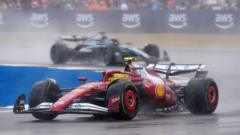Is Hamilton Struggling with Ferrari's Unbelievably Tricky Wet Performance?

Understanding the Challenges Faced by Lewis Hamilton and Ferrari at the British Grand Prix
The British Grand Prix at Silverstone is not just a race; it’s a storied event steeped in history and tradition within the world of Formula 1. For Lewis Hamilton, a seven-time world champion, the circuit holds a special place in his heart, as he has won the prestigious race an astounding nine times. However, the recent race presented a different narrative, one that highlighted the complexities and challenges of modern F1 racing, especially when driving a Ferrari in unpredictable wet-dry conditions. This article delves into the race dynamics, Hamilton’s experience, and what it means for the future of both the driver and the Ferrari team.
The Race Conditions: A Test of Skill and Strategy
The race commenced under damp conditions, which later transformed into a mix of rain and dry patches on the track. Such fluctuating circumstances can significantly affect a driver's performance and a car’s handling. For Hamilton, this particular Grand Prix was marked by difficulties that he described as “unbelievably tricky.” The unpredictability of the weather not only challenged the drivers but also tested the strategies employed by their respective teams.
Wet-Dry Challenges
Racing in wet conditions requires different skill sets and strategies compared to dry weather. The track's moisture can lead to reduced grip, making the car more challenging to handle. Hamilton, who was still acclimatizing to his new Ferrari, found the car particularly difficult to manage in these conditions. He expressed, “It’s only my second time driving in the wet in this car. I can’t even express to you how hard it is.” This underscores the learning curve he faces in adapting to the nuances of his Ferrari, particularly in less-than-ideal conditions.
Strategic Decisions and Their Consequences
One critical aspect of racing is the strategic decisions made by the team. A notable moment during the race was Charles Leclerc’s premature decision to switch to slick tires during the damp conditions. This move backfired, leading to a disappointing 14th place finish. Leclerc’s struggles were echoed in Hamilton’s experience, as both drivers faced difficulties in fully extracting their car's potential throughout the race.
Hamilton’s Reflections on Performance
Following the race, Hamilton took a moment to reflect on his performance and the car’s capabilities. He noted, “I learned a lot today; there’s lots to take from the day.” Despite finishing fourth—a position that, while respectable, did not place him on the podium—Hamilton remained optimistic about the future. He emphasized the importance of collaboration with the design team to enhance the car’s performance for the upcoming season.
The Need for Stability and Balance
Hamilton highlighted his desire for a “consistent balance” in the car, particularly in low-speed corners. This is crucial for a driver who thrives on precision and control. The feedback he provides is invaluable for the engineers and designers, who will work on improving the car's balance and handling characteristics. His focus on stability speaks to the broader need for Ferrari to adapt and innovate in a highly competitive environment.
Ferrari's Path Forward
Ferrari has faced its share of challenges this season, with Hamilton’s fourth-place finish marking his third such result this year. The team has introduced new upgrades, including a revamped floor, but the results have been mixed. Team Principal Frederic Vasseur acknowledged the struggles with overtaking, suggesting that the team faced significant difficulties when in “dirty air.” This term refers to the disrupted airflow around the car, which can hinder performance and make overtaking more challenging.
Upgrade Strategy and Future Potential
The ongoing development of the car is essential for Ferrari to climb back into contention. Hamilton’s insights about needing a more stable car are aligned with Ferrari’s plans to implement further upgrades in the coming races. The collaboration between driver feedback and engineering prowess will be vital for the team’s success moving forward.
The Competitive Landscape of Formula 1
The British Grand Prix also showcased the rising competitiveness of other teams, notably McLaren, whose drivers Lando Norris and Oscar Piastri finished first and second, respectively. Their performance serves as a reminder of the ever-shifting dynamics in Formula 1, where a single race can alter the narrative of the entire season.
Lessons from Competitors
As Hamilton and Ferrari navigate this challenging season, they can learn valuable lessons from their competitors. The success of McLaren highlights the importance of adaptability and consistency, qualities that Hamilton and his team will need to embrace. With the right strategies and improvements, Ferrari can regain its competitive edge.
Conclusion: The Road Ahead for Hamilton and Ferrari
The road ahead for Lewis Hamilton and Ferrari is filled with both challenges and opportunities. While the recent race at Silverstone may not have ended in the desired outcome, it provided critical insights into the car’s performance and the team’s strategies. As Hamilton continues to adapt to his new car, the collaboration with his engineering team will be crucial for future success.
Looking forward, the focus will be on improving car stability, enhancing race strategies, and learning from the successes and missteps of competitors. The journey of Hamilton and Ferrari is one of resilience, determination, and the relentless pursuit of excellence in the fast-paced world of Formula 1.
FAQs
What were the key challenges faced by Lewis Hamilton during the British Grand Prix?
Hamilton faced significant challenges due to the wet-dry conditions of the race, which made the Ferrari difficult to handle. He struggled with car stability and balance, especially in low-speed corners.
How did Ferrari perform in the British Grand Prix?
Ferrari had a tough race, with Hamilton finishing fourth and teammate Charles Leclerc finishing in 14th place after making a poor tire strategy decision. The team struggled with overtaking and overall pace.
What improvements does Hamilton suggest for the Ferrari car?
Hamilton emphasized the need for a consistent balance and improved handling, particularly at low speeds. He also mentioned the importance of collaborating with the design team to enhance the car's performance for future races.
In the world of Formula 1, every race is a learning experience. As Hamilton and Ferrari work toward improvement, how will they adapt their strategies and innovations to reclaim their competitive edge? #F1 #LewisHamilton #Ferrari
Published: 2025-07-06 20:48:29 | Category: sport



